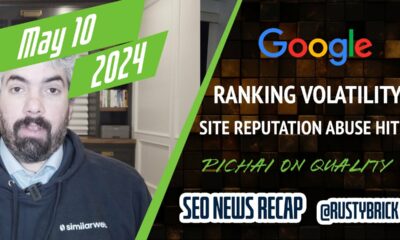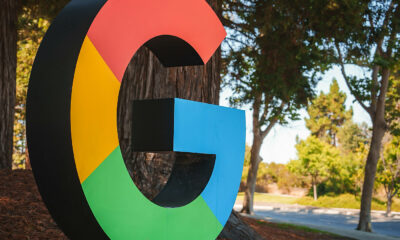PPC
3 Must-Dos When Tracking Multiple Conversion Actions
Being an account manager at an agency, you come across many different scenarios. Just like snowflakes, there are no two accounts that will ever be the same. You may have two eCommerce accounts but with different products and investments, goals may be drastically different. Or the value of a lead generation form for Business A may be much less than that of Business B. No matter the difference, it’s our job to make ourselves an extension of our client’s marketing team and learn, learn, learn.
When new accounts are brought on, we can generalize a couple of things such as;
- The product(s) that are being marketed.
- If the business is eCommerce or Lead Generation.
From that point, the dialog begins regarding goals, what is meaningful to the business, etc. So what happens when eCommerce and lead generation coincide under the same account. Today, I want to walk you through three must-dos that will help you to keep the balance and ensure that everyone plays nice.
Don’t Ever Discount A Goal
When you first learn that you will be tracking forms and general transactions, ask questions such as;
- How many forms do you have across your site?
- If a user fills out a form and completes a transaction, will they still be contacted via the sales team?
- What’s the value of a form lead versus a general transaction?
- Are leads and transactions tracked in the same CRM (Customer Management Software)
The end goal is to understand all the processes and to understand how the business works together as a whole. No question is too silly and from experience, your contacts will love to answer your questions. As mentioned above, we want to be an extension of our client’s marketing team and therefore by asking questions, we are immersing ourselves in their business. Did I mention that no question is too silly?
Allow Keywords to Speak for Themselves
This is a tough one. When thinking about different conversion actions, it’s easy to say that when this term is searched for, someone is obviously looking to directly purchase or vise versa. I have found this to be the farthest thing from the truth in some situations. You would be surprised at terms that are searched for by decision-makers and the end result is a form fill that leads to a huge win. My recommendations here are as follows;

- Keep the conversation going. If you see “obvious” transactional search terms leading to form fills, speak up. Tell your client. It may open up internal conversations about how users are viewing products and speaking of products.
- Test, test, test. Test keywords that speak to various parts of the funnel. Learn how users are searching and use that to your advantage.
Allow Creative to Meet The End-User
Last but certainly not least, allow your findings to dictate how you speak to users. Don’t be afraid to test “lead generation” language around seemingly eCommerce/Transactional products. “Shop Now” may be too abrasive, whereas “Learn More”, may speak to the user who isn’t ready to purchase and simply wants more information. On the flip-side, “Shop Now” may open the door for someone who is looking to purchase but once they make it to your site, they realize they meet other qualifications and need that conversation with a sales representative.
Final Thoughts
Like a few other posts I have written, the end story is that you should always test and allow the data to speak. However, we need to also be vulnerable and ask questions to gain a greater understanding of our clients.
PPC
The Ultimate Guide to Click Fraud

Click fraud involves deceptive practices that affect campaign integrity and efficiency of digital marketing campaigns. It presents a significant challenge to online advertisers.
Click fraud occurs when an individual, script, or program maliciously clicks on an online advertisement without any genuine interest in the offer behind the click.
This deceptive practice drains advertising budgets and skews marketing data.
At its core, click fraud is an attempt to simulate the appearance of interest in an advertisement.
This can be done for various reasons. They include draining a competitor’s advertising budget or earning undue revenue from pay-per-click (PPC) agreements.
Unlike legitimate clicks that reflect genuine interest, clicks generated through fraud provide no real value to advertisers.
Types of Click Fraud
Understanding the different mechanisms through which click fraud can be perpetrated is crucial for its detection and prevention. The most common types include:
- Bot Clicks: Automated programs, known as bots, mimic human behavior to click on ads. These bots can operate at a massive scale, generating vast amounts of fraudulent traffic.
- Competitor Clicks: In some cases, competitors may engage in clicking on ads maliciously to deplete the advertising budgets of their rivals, thereby hampering their ability to compete effectively.
- Click Farms: Groups of individuals are hired to manually click on advertisements. These click farms can be found across the globe. They are often used to generate fake clicks at a scale that automated systems can detect.
Bot Clicks
Bot clicks represent one of the most sophisticated and challenging forms of click fraud facing online advertisers today.
These automated programs are designed to mimic human behavior, interacting with digital ads as if they were genuine users.
The sophistication of such bots varies significantly; some operate on a basic level, randomly clicking on ads across the web. Others are highly advanced, capable of mimicking human browsing patterns, completing forms. They can even bypass security measures designed to differentiate between human and non-human traffic.
How Bot Clicks Operate
Bot clicks are generated through automated scripts or software programs. These bots can be distributed across numerous devices and networks. This makEs their traffic appear to originate from different locations and IP addresses.
This distribution helps to mask the fraudulent activity, complicating detection efforts.
Advanced bots further disguise their nature by emulating human interaction times, mouse movements, and even engaging in “random” non-linear browsing behaviors to evade pattern recognition systems.
Scale of Operation
The scale at which bots can operate is a significant part of what makes them such a formidable challenge.
A single botnet, which is a network of infected computers controlled by a hacker, can generate millions of clicks without any direct human involvement.
This capability allows fraudsters to inflict substantial financial damage on targeted advertising campaigns within a very short timeframe.
Impact on Advertisers
The impact of bot clicks on advertisers is multifaceted:
- Financial Loss: The most immediate effect is financial. Advertisers pay for clicks, assuming they represent genuine interest. Bot clicks drain budgets without providing any return on investment.
- Skewed Analytics: Bots inflate engagement metrics, leading advertisers to make misinformed decisions about the effectiveness of their campaigns. This distortion can misguide marketing strategies, budget allocation, and performance assessment.
- Deterioration of Advertiser-Publisher Trust: Over time, unchecked bot traffic can erode the trust between advertisers and publishers. Advertisers may become skeptical of the traffic quality provided by certain platforms, impacting future advertising relationships and negotiations.
Combating Bot Clicks
Efforts to combat bot clicks involve a combination of technology, vigilance, and collaboration:
- Advanced Detection Tools: Sophisticated detection tools analyze click patterns, verify IP addresses, and monitor user behavior to help identify and filter out bot traffic.
- Machine Learning and AI: Machine learning algorithms and AI can enhance the ability to detect anomalies in traffic that suggest bot activity, continually improving detection accuracy over time.
- Industry Collaboration: Sharing information about known bots and attack patterns within the industry can help advertisers and platforms stay one step ahead of fraudsters.
Understanding the nature and operation of bot clicks is essential for advertisers seeking to protect their investments.
Competitor Clicks
Competitor clicks refer to a deliberate and malicious practice where businesses click on their rivals’ online advertisements.
This form of click fraud is driven by the desire to undermine a competitor’s marketing efforts, draining budgets and thus making it more difficult for them to maintain a visible online presence.
As well as financial strain, the behaviour can produce inaccurate data. This can lead advertisers to change their campaigns in ways they otherwise wouldn’t if the information was honest.
Unlike bot-generated clicks, competitor clicks involve direct human action. This can make them challenging to identify due to their seemingly legitimate nature.
This tactic can be particularly appealing in highly competitive industries where advertising costs are high, and market share is fiercely contested.
Strategies for Mitigation
Addressing competitor clicks requires a multifaceted approach that combines vigilance, technological solutions, and potentially legal action:
- Monitoring and Analysis: Regularly monitoring ad performance and analyzing traffic sources for irregularities can help identify suspicious patterns indicative of competitor clicks.
- Geo-targeting and Ad Scheduling: Limiting ads to specific geographic locations or times can help avoid exposure to competitors, reducing the likelihood of fraudulent clicks.
- Legal Recourse: In some jurisdictions, engaging in click fraud can have legal consequences. If competitor clicks can be conclusively traced back to a source, legal action may be a viable option.
- Engagement with Ad Platforms: Many advertising platforms have mechanisms in place to identify and refund fraudulent clicks. Maintaining open communication with these platforms can help ensure that you’re not paying for illegitimate traffic.
Understanding the dynamics of competitor clicks is crucial for any business reliant on online advertising. By employing targeted strategies to mitigate their impact, businesses can protect their advertising investments.
Click Farms
Click farms represent a more human-centric approach to generating fraudulent clicks on digital advertisements in comparison to Bot Clicks.
These operations consist of networks of individuals who are paid to manually click on ads, visit websites, and even interact with content to feign genuine user engagement.
Unlike bots click farms use human labor to produce clicks and interactions. This makes it harder for algorithms to distinguish them from legitimate traffic.
As well as the effects associated with bots and competitors, clickfarms can be harmful to an advertiser’s reputation. Platforms and consumers may begin to associate certain brands with low-quality traffic, potentially damaging reputations over time.
Operation and Global Presence
Click farms operate in a relatively straightforward manner: individuals are recruited and organized into groups, often in low-wage countries, to click on specified advertisements or interact with digital content for hours at a time.
These operations can range from small setups with a handful of individuals to large-scale operations employing hundreds or even thousands of people.
The global presence of click farms is widespread.
The decentralized nature of click farms, coupled with the use of VPNs and proxy servers to mask the real geographical location of the clicks, complicates the task of tracing and addressing this form of click fraud.
Challenges in Detection and Prevention
Detecting click farm activity poses a significant challenge due to the human element involved. However, some strategies can be employed to mitigate their impact:
- Pattern Recognition: Advanced analytics and machine learning tools can help identify patterns typical of click farms, such as unnatural spikes in traffic or clicks coming from geographical locations not matching the target audience.
- Strengthened Ad Network Policies: Ad networks continuously improve their policies and detection mechanisms to identify and penalize advertisers or publishers involved in click farm activities.
- Selective Targeting and Engagement: By carefully choosing where and when ads are displayed, and by closely monitoring engagement patterns, advertisers can reduce their exposure to click farms. This might include avoiding advertising in regions known for click farm operations or adjusting bids based on the quality of traffic received.
Mitigating the Risk
To mitigate the risk of click farm fraud, advertisers must remain vigilant, employing a combination of technology and best practices to identify and reduce fake clicks. This includes regularly auditing traffic sources, implementing more stringent targeting criteria, and working closely with ad platforms to report and address suspicious activities.
Importance of Understanding Click Fraud for Businesses and Advertisers
For businesses and advertisers, the ramifications of click fraud extend beyond just wasted financial resources.
It can lead to misguided decisions based on distorted data, misallocation of marketing budgets, and diminished campaign performance.
Understanding click fraud in all its forms and nuances is the first step in developing effective strategies to combat it. This knowledge not only aids in safeguarding advertising investments but also ensures the integrity of marketing campaigns, allowing for genuine engagement with potential customers.
In a time when digital visibility is crucial for market success, safeguarding against fraudulent activities is essential.
Notable Click Fraud Operations
1. Methbot Operation
- Overview: Methbot was one of the largest and most sophisticated ad fraud schemes ever uncovered, primarily active around 2015-2016. It was operated by a Russian cybercriminal group and named after its key software, “Methbot.”
- Method: The operation used an extensive network of bots, running on over half a million fake web pages that mimicked the sites of legitimate publishers. These bots simulated human behavior to view video ads, generating fraudulent ad views on a massive scale.
- Impact: Methbot generated upwards of $3 to $5 million in fraudulent ad revenue per day, according to some estimates. Its sophistication and scale highlighted the vulnerabilities in digital ad ecosystems and the need for advanced detection and prevention strategies.
2. 3ve Operation
- Overview: Uncovered in 2018, 3ve was another extensive digital ad fraud operation. It combined three separate campaigns, hence the name 3ve (pronounced “Eve”), and involved over 1 million compromised IP addresses.
- Method: This operation used a mix of techniques, including infecting users’ computers with malware to create a botnet for generating fraudulent ad views and clicks, as well as creating fake websites to host ads and utilizing spoofed IP addresses to simulate geographically relevant traffic.
- Impact: 3ve affected thousands of advertisers and siphoned off millions of dollars before it was taken down through a coordinated effort by Google, White Ops (now HUMAN Security), and various law enforcement agencies. The operation led to several arrests and highlighted the importance of cross-industry collaboration in combating ad fraud.
3. ZeroAccess Botnet
- Overview: ZeroAccess was a prominent botnet that, at its peak, affected millions of computers worldwide. It was primarily used for click fraud and Bitcoin mining.
- Method: The botnet infected computers through various vectors, turning them into bots that executed click fraud on a massive scale, alongside other malicious activities. ZeroAccess used sophisticated methods to avoid detection and removal, making it one of the more resilient threats at the time.
- Impact: The financial damage caused by ZeroAccess in terms of wasted advertising spend and bandwidth consumption was significant, running into millions of dollars. Efforts by companies like Microsoft and law enforcement led to a partial takedown of the botnet, underscoring the challenges of eradicating such distributed threats.
These case studies exemplify the diversity of click fraud operations, from botnets and malware to sophisticated ad fraud schemes.
Detecting Click Fraud
Detecting click fraud is a critical component of digital advertising security, ensuring that budgets are spent efficiently and that campaign data reflects genuine user engagement.
Identifying fraudulent activity requires a combination of vigilant monitoring, sophisticated tools, and an understanding of traffic and click pattern irregularities.
Indicators of Click Fraud
Several key indicators can signal the presence of click fraud in digital advertising campaigns:
- Abnormally High Click-Through Rates (CTR): While a high CTR is generally positive, an unexpected or unexplained surge can be indicative of fraudulent activity.
- Short Duration Visits: If analytics show a significant portion of clicks result in very brief site visits, often seconds, this may suggest non-genuine interaction.
- High Bounce Rates: Similar to short-duration visits, a high bounce rate with a correspondingly high CTR might indicate fraudulent clicks.
- Geographic Inconsistencies: Receiving clicks from regions not targeted by your campaign or from locations known for click farms can be suspicious.
- Irregular Times of Activity: A sudden influx of clicks during off-peak hours, especially in patterns not consistent with your typical traffic, could suggest fraud.
Tools and Technologies for Detection
A variety of tools and technologies are available to help detect and mitigate click fraud:
- Automated Detection Software: Many platforms offer built-in fraud detection features. Additionally, third-party software can provide an extra layer of protection by analyzing traffic and identifying potential fraud.
- AI and Machine Learning: Advanced solutions utilize artificial intelligence and machine learning algorithms to recognize patterns and behaviors indicative of click fraud. These systems can adapt over time, improving their detection capabilities.
- Traffic Analysis Tools: Tools that offer deep insights into traffic sources, behavior patterns, and engagement metrics can help advertisers identify inconsistencies that may signal fraud.
Analyzing Traffic and Click Patterns for Irregularities
Effective detection of click fraud involves a detailed analysis of traffic and click patterns, looking for anomalies and irregularities:
- Benchmarking Normal Traffic Patterns: Establishing a baseline for normal traffic and engagement patterns allows for easier identification of anomalies. This includes understanding typical user behavior, average session durations, and normal CTRs for your campaigns.
- Segmentation Analysis: Breaking down traffic by variables such as device type, geographic location, and time of day can help isolate suspicious activity. For example, an excessive number of clicks from a single device type or location might indicate fraud.
- Looking for Patterns in IP Addresses: Repeated clicks from the same IP addresses, especially in short successions, can be a strong indicator of fraudulent activity. IP analysis can also reveal the use of VPNs and proxies commonly used by click farms and bots.
Impact of Click Fraud
The impact of click fraud extends beyond immediate financial losses, affecting the broader integrity of online advertising ecosystems, skewing campaign data, and influencing marketing strategies. Understanding the multifaceted consequences of click fraud is essential for businesses seeking to navigate the digital advertising landscape effectively.
Long-term Consequences for Online Advertising Ecosystems
The pervasive issue of click fraud poses significant threats to the sustainability and trustworthiness of online advertising ecosystems:
- Decreased Advertiser Confidence: As advertisers become more aware of the prevalence of click fraud, their confidence in digital advertising platforms may wane. This decreased trust can lead to reduced advertising spend and a search for alternative marketing channels.
- Inflation of Advertising Costs: To compensate for losses due to fraud, platforms may increase the cost of advertising, further straining advertiser budgets and exacerbating the challenge of achieving a positive return on investment.
- Innovation and Regulation: While the challenge of click fraud spurs innovation in detection and prevention technologies, it also calls for more stringent regulations and standards within the industry. This evolving landscape can both offer new opportunities and impose additional burdens on advertisers and platforms alike.
Preventing Click Fraud
Preventing click fraud is essential for maintaining the integrity of digital advertising efforts and ensuring that marketing budgets are spent effectively.
Through a combination of best practices, proactive fraud detection measures, and strategic platform selection, advertisers can significantly reduce their exposure to fraudulent activities.
Best Practices for Advertisers and Marketers
- Educate Your Team: Awareness is the first step in prevention. Ensure your marketing team understands what click fraud is, how it can impact your campaigns, and the common signs of fraudulent activity.
- Use Anti-Fraud Technologies: Invest in reputable anti-fraud technologies and services that specialize in detecting and mitigating click fraud. These tools can provide an additional layer of protection by analyzing traffic in real-time and flagging suspicious activities.
- Implement Strict Targeting: Narrow your ad campaigns’ targeting to focus on demographics and geographies that are most relevant to your business. This approach not only improves campaign effectiveness but also reduces the likelihood of attracting fraudulent clicks.
Setting Up Fraud Detection Measures
- Enable Click Fraud Monitoring: Many ad platforms offer monitoring tools that can be enabled to track the behavior of clicks and detect patterns indicative of fraud.
- Analyze Traffic Regularly: Conduct regular analyses of your traffic data for abnormalities such as spikes in traffic from specific regions or devices, short session durations, and unusually high bounce rates.
- Use CAPTCHAs and IP Blocking: Implement CAPTCHAs for interactive elements of your campaigns to deter bots, and use IP blocking to exclude traffic from known fraudulent sources.
Choosing the Right Platforms and Ad Networks
- Research and Select Trusted Platforms: Opt for advertising platforms and networks with robust anti-fraud measures and positive reputations for managing click fraud. Platforms that are transparent about their efforts to combat fraud are generally more reliable.
- Demand Transparency: Work with platforms that provide detailed reporting and analytics tools, allowing you to see where your ads are being placed and how they are performing.
How Do I Get Rid of Click Fraud?
Immediate Steps to Take When You Detect Click Fraud
- Pause Your Campaigns: Temporarily pausing affected campaigns can prevent further loss until the source of fraud is identified and addressed.
- Report to Ad Platforms: Immediately report the suspected fraud to your ad platform. Provide them with detailed evidence of the suspicious activity to support your claim.
Working with Ad Platforms for Refunds and Blocking Fraudulent Sources
- Request Refunds: Many ad platforms have procedures in place for investigating click fraud claims and issuing refunds for fraudulent clicks. Be prepared to provide detailed data to support your refund request.
- Collaborate on Prevention: Work closely with ad platforms to identify and block fraudulent sources. This collaboration can lead to the development of customized solutions to protect your specific campaigns.
Continuous Monitoring and Adjustment Strategies
- Regularly Review Campaign Performance: Continuously monitor your campaign performance for signs of click fraud. Adjust your strategies based on insights gathered from your ongoing analysis.
- Stay Updated on Trends: Click fraud tactics evolve, so staying informed about the latest trends in fraud and prevention measures is crucial. Regularly updating your knowledge and tools can provide ongoing protection for your campaigns.
Preventing click fraud requires a proactive, informed approach. By implementing these best practices and remaining vigilant against new threats, advertisers can better protect their investments and ensure the integrity of their online marketing efforts.
Legal and Ethical Considerations
The issue of click fraud brings to the forefront significant legal and ethical considerations within the digital advertising industry. Understanding the legal landscape, ethical implications, and available recourse can empower businesses to navigate these challenges more effectively.
Is Click Fraud Legal?
Click fraud is considered illegal under various laws that prohibit fraudulent activities and cybercrime. However, the specific legal classification and penalties associated with click fraud can vary significantly by jurisdiction.
At its core, click fraud involves deception and financial harm, aspects that are generally actionable under laws related to fraud, computer misuse, and unfair competition.
Overview of Laws and Regulations Against Click Fraud
- Computer Fraud and Abuse Act (CFAA) in the U.S.: This federal statute is one tool used to combat click fraud, addressing unauthorized access or use of computer systems, which can include the deployment of bots for fraudulent clicking.
- Wire Fraud Statutes: In many jurisdictions, click fraud can be prosecuted under general wire fraud statutes, given that it involves the use of telecommunications or the internet to carry out fraudulent schemes.
- Consumer Protection Laws: Laws aimed at protecting consumers from deceptive practices may also be applied to click fraud, particularly when false advertising or misrepresentation is involved.
The complexity of digital advertising ecosystems and the transnational nature of the internet can complicate legal actions against click fraud, highlighting the need for international cooperation and specific cybercrime legislation.
Ethical Considerations in Digital Advertising
Beyond legality, click fraud raises ethical concerns that can undermine trust in digital ecosystems:
- Transparency: Advertisers and platforms have a duty to ensure transparency in how clicks are generated and accounted for. Concealing or ignoring fraudulent activities can erode trust among all stakeholders.
- Fair Competition: Click fraud distorts competition by unfairly depleting competitors’ advertising budgets, violating principles of fair play.
- Consumer Trust: Engaging in or tolerating click fraud can diminish consumer trust in digital advertisements, affecting the credibility of online marketing channels.
Adhering to ethical standards is crucial for maintaining the integrity and sustainability of digital advertising.
Future of Click Fraud
As digital advertising continues to evolve, so do the methods and tactics of click fraud.
Understanding emerging trends, the role of advanced technologies in combating this fraud, and making informed predictions about the future of online advertising are crucial for staying ahead in this ongoing battle.
Emerging Trends and Technologies
The landscape of click fraud is constantly shifting, with fraudsters regularly adopting new technologies to carry out their schemes. Some emerging trends include:
- Sophisticated Botnets: As bot detection techniques become more advanced, so too do the botnets. These networks are increasingly mimicking human behavior more accurately, making them harder to detect.
- Machine Learning for Fraud Creation: Just as defenders use machine learning to detect fraud, attackers are beginning to use these technologies to learn and adapt to new detection methods, creating a cat-and-mouse dynamic.
- Cross-Platform Fraud: Fraudulent activities are spreading across platforms, from traditional web-based advertising to mobile apps and social media platforms, exploiting the integrated nature of digital ecosystems.
The Role of AI and Machine Learning in Combating Click Fraud
Artificial Intelligence (AI) and Machine Learning (ML) are at the forefront of the fight against click fraud, offering powerful tools to identify and mitigate fraudulent activities:
- Pattern Recognition: AI/ML algorithms excel at detecting patterns and anomalies in data, including subtle signs of fraud that might elude human analysts.
- Predictive Analytics: These technologies can predict potential fraudulent activities by analyzing historical data and identifying risk factors associated with click fraud.
- Real-Time Monitoring and Response: AI systems can monitor campaign data in real-time, providing immediate responses to suspected fraud, thereby minimizing potential losses.
Predictions for the Online Advertising Industry
The future of click fraud and its impact on the online advertising industry hinge on several factors, including technological advancements, regulatory changes, and shifts in advertiser strategies:
- Increased Investment in Fraud Detection: Businesses are likely to allocate more resources toward advanced fraud detection solutions as the cost of click fraud becomes increasingly untenable.
- Greater Collaboration Among Stakeholders: There may be an uptick in collaboration between advertisers, platforms, and regulatory bodies to establish industry-wide standards and share intelligence on fraudulent activities.
- Regulatory and Legal Evolution: New laws and regulations specifically addressing online fraud and digital advertising practices are expected to emerge, providing clearer frameworks for combatting click fraud.
- Shift Toward Quality Over Quantity: Advertisers might prioritize metrics that reflect genuine user engagement and conversion over sheer volume of clicks, adjusting their strategies to focus on quality traffic.
As the digital advertising ecosystem becomes more complex, the battle against click fraud will continue to require vigilance, innovation, and cooperation among all stakeholders.
The ongoing development of AI and ML technologies represents a opportunity, promising more effective tools for detecting and preventing click fraud.
However, the adaptability of fraudsters means that strategies must continually evolve.
The future of online advertising will likely be characterized by a heightened emphasis on security, transparency, and sustainable engagement practices, ensuring that investments in digital ads yield genuine value.
Click Fraud Protection Software and Service Companies
In the evolving battle against click fraud, a variety of companies have emerged, each offering unique solutions designed to protect advertisers and ensure the integrity of digital advertising.
ClearTrust https://cleartrust.cc/ offers tailored protection mechanisms focusing on transparency and trust in ad transactions.
Lunio https://lunio.ai/ leverages AI to provide advertisers with insights and tools for combating fraudulent traffic in real-time.
CHEQ https://essentials.cheq.ai/ introduces a comprehensive suite for digital security, including click fraud prevention, with an emphasis on real-time protection.
Fraud0 https://www.fraud0.com/ specializes in detecting and preventing ad fraud using advanced analytics and real-time monitoring, targeting a wide range of online fraud types.
Singular https://www.singular.net/ stands out with its marketing analytics platform that integrates fraud prevention, aiming to optimize advertising spend and enhance ROI.
TrafficGuard https://www.trafficguard.ai/ proactively blocks fraudulent traffic, safeguarding advertising budgets with precision and granularity.
IPQualityScore https://www.ipqualityscore.com/ offers a robust suite of tools for fraud prevention, focusing on IP address and device reputation to block unwanted interactions.
FraudBlocker https://fraudblocker.com/ emphasizes an easy-to-use, efficient solution for detecting and blocking click fraud, enhancing campaign performance.
SpiderAF https://spideraf.com/ is dedicated to fighting ad fraud with its automated detection software, catering specifically to the needs of digital agencies and app developers.
OpticksSecurity https://optickssecurity.com/ tackles ad fraud through a security-first approach, using sophisticated signal analysis to identify threats.
ClickGuard https://www.clickguard.com/ provides customizable protection against click fraud, offering granular control over traffic filtering and ad spend optimization.
Clixtell https://www.clixtell.com/ focuses on detecting and preventing click fraud and conversion fraud, offering tools for enhanced campaign transparency and security.
HUMAN Security (formerly White Ops) https://www.humansecurity.com/ combats sophisticated bot attacks and digital fraud with a human verification engine, ensuring genuine user interactions across digital advertising.
AdsDefender https://www.adsdefender.com/ offers comprehensive click fraud protection with a focus on real-time detection and automated blocking, aiming to maximize the efficiency of digital ad spending.
PPC
Low Risk, High Reward YouTube Ads alexking

Do you want to introduce your client to YouTube ads but thought it was too high risk?
Have you thought about diversifying your marketing channels and want to know how to launch on YouTube with minimal risk?
You’re not alone. More and more advertisers have either spotted the potential of YouTube or want to add to their existing profitable channels. Unfortunately a significant number have subsequently retreated after seeing poor initial results.
The lowest risk way to get results with YouTube ads (and possibly the highest return), is with YouTube placement targeting.
By serving your ads on specific YouTube videos or channels that are a perfect match for your product or service, you minimize wasted impressions on an irrelevant audience. In turn you maximize your return on ad spend.
The Pyramid Targeting Technique: A Strategic Framework
As part of my “Pyramid Targeting Technique” model for profitable YouTube ad campaigns, placement targeting sits at the top.
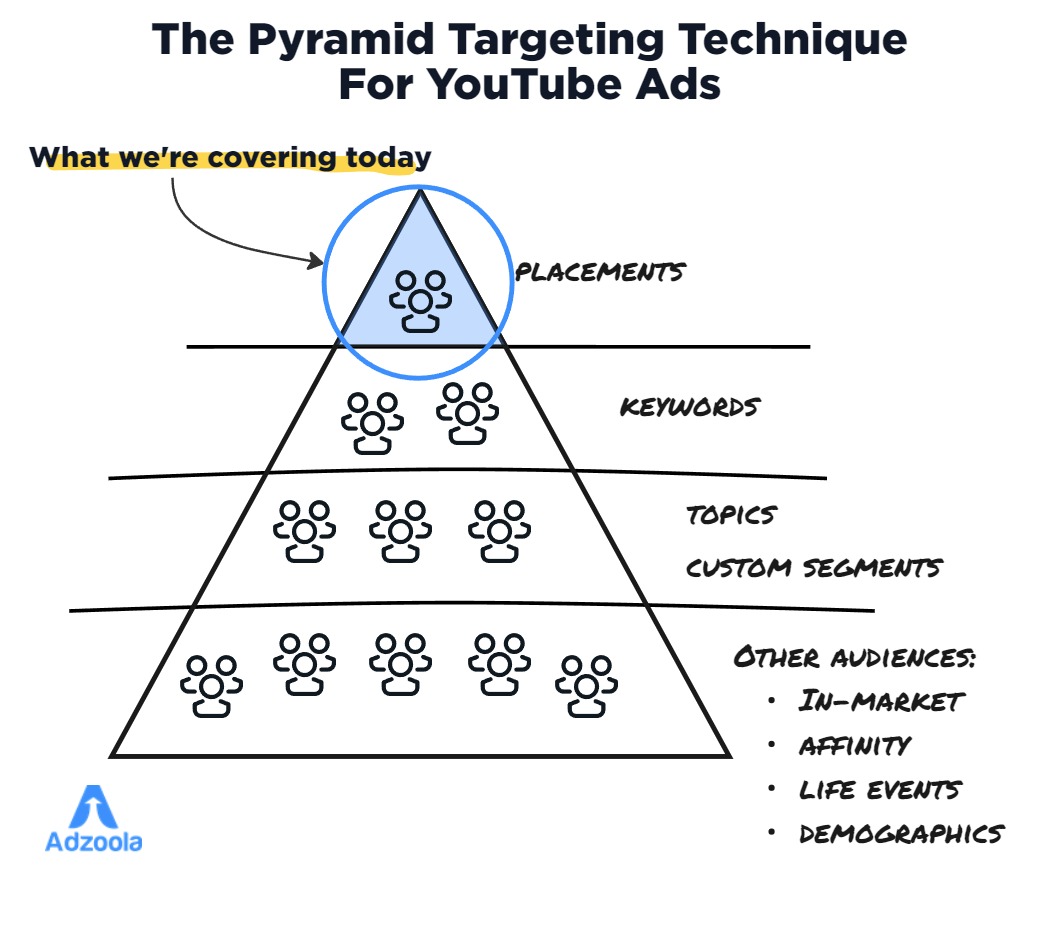
This laser-focused method allows you to hand-pick exactly where your ads will be displayed – giving you unrivaled control.
Here’s why you’ll want to start with YouTube’s placement targeting:
1. Profit-Producing ROI Potential
With tight audience targeting you’re putting your ads directly in front of a highly relevant, interested crowd. This precision-striking ability maximizes your chances of driving conversions by meeting their intent with your message.
2. Small Budget, Big Results
Since you can start with a small number of placements, placement targeting is ideal for affordably testing different ads and messages without blowing your budget. Find your winners first, then scale up (working your way down the pyramid).
3. You’re the Master of Your Audience
You choose the specific videos and channels to run your ads on, rather than relying on Google’s algorithms to figure out relevancy and serve your ads. This granular control helps ensure your ads stay hyper-focused on your prime prospects.
With such a narrow targeting method, audience sizes will naturally be smaller than broader methods like keywords, topics, custom segments and interests. But that’s the advantage – you can consistently put your brand in front of an audience you know have intent and interest at the moment you’re reaching them.
Placement Pitfalls to Avoid & Quick-Fire Tips
Placement targeting isn’t always a magic bullet. Advertisers often struggle with a few common pitfalls that sabotage their results. These will help you avoid being one of those who say “I tried, it doesn’t work” or “It won’t get conversions”.
1. Bidding Too Low
Given placement targeting is the most precise form of targeting on YouTube, it often requires higher bids to effectively compete in the auction. In practice, many advertisers pay less than their maximum bid due to the auction dynamics. Remember, you’re targeting an ultra-focused audience – it’s worth paying for that privilege.
2. Overly Restrictive Layered Targeting
Combining placement targeting with too many additional targeting restrictions, such as narrow age or geographical limits, can overly constrict the audience size and hinder performance. A light touch is often best.
3. Manual Optimization Neglect
Some advertisers struggle with high cost-per-acquisition (CPA) on placement campaigns. Often they haven’t engaged in regular manual optimizations. As it’s a manual campaign you’ve got to review and optimize regularly.
4. Misusing as a Scale Tool
While extremely powerful, placement targeting simply won’t reach the same stratospheric audience levels available on YouTube as broader methods. Use it as an intelligent testing bed and build scale with other targeting methods (further down the pyramid).
5. Keep your video and channel placements in different campaigns for easier management and optimization.
Keep your video and channel placements in different campaigns for easier management and optimization.
6. Mixing Videos and Channels
Keep your video and channel placements in different campaigns for easier management and optimization.
7. Path of Least Resistance
When starting out, it’s often easier to find well-performing individual video level placements rather than channel placements. Build from that base.
Setting Up YouTube Placements
To set up your YouTube ad campaign targeting placements, you’ll start by selecting ‘create a campaign without a Goal’s guidance’, then choose the Video campaign.

You can use placement targeting (and the other content targeting options) in four video campaign subtypes:
- Video Views – using Max CPV, Target CPV (with Multi-format ads enabled)
- Efficient Reach – using Target CPM
- Non-skippable – using Target CPM
- Audio – using Target CPM
I’d suggest starting with the Video Views Campaign (VVC) subtype if you’re running a direct-response style ad because you can use Maximum CPV (cost per view) bidding.
For in-stream skippable ads, you’ll only pay when someone watches your ad for 30 seconds or more (or watches the full video if it’s less than 30 seconds.) This is saves you money when you’re launching a new client or starting to advertise on YouTube, as it lowers your risk. You’ve chosen specific relevant videos or channels to show your ad on and you only pay when someone chooses not to skip in the first 30 seconds.
So select Video Views as the campaign subtype:

During setup it’s critical that you go to Network settings and uncheck ‘Video partners on the Google Display Network’. It’s easy to forget but it’ll cost you if you do. If you have this checked Google can (and often will) show your video ad on the Display Network, even if you only add placements to your targeting.

Scroll down and you’ll see the Content targeting options – keywords, topics and placements. Select Placements and navigate to ‘Enter’ so you can add your placements.
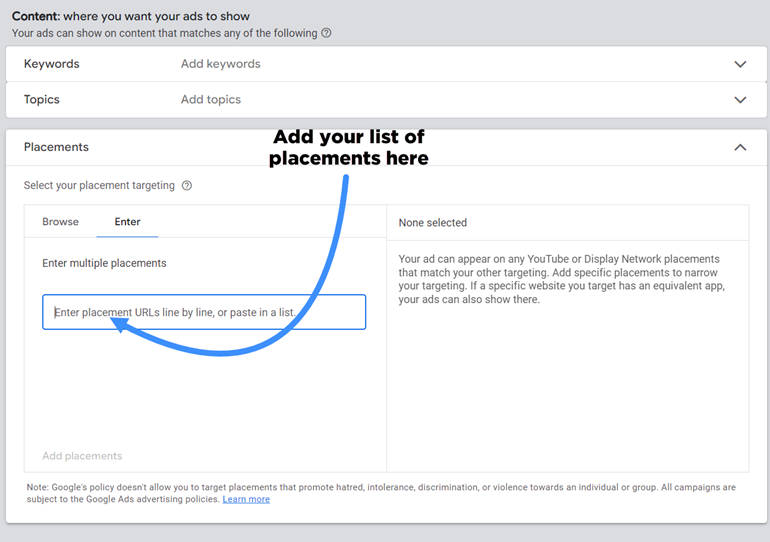
Don’t move on until you’ve actually clicked ‘Add X placements’, otherwise your placements won’t be added. I know it sounds obvious but I’ve seen cases where this has happened. It’s horrible having to tell someone they didn’t actually add the placements and the campaign has been spending that way for a while!
You can use research tools like my own, Adzoola, to find, filter and add video or channel placements to run focused campaigns to a relevant audience.
Test a handful of promising placements, analyze the results, then either maximize the winners or restart your sourcing process.

Don’t Sleep on Placements: The Low-Risk Testing Bed
For advertisers looking to maximize ROI from their YouTube ad spend – especially those operating with smaller budgets – placement targeting needs to be a core part of your strategy. The ability to put your brand and messaging in front of an ultra-relevant audience in a cost-effective manner is a game-changing advantage.
While placement targeting may require more manual management than automated campaigns, having that level of hands-on control could be the key to cracking profitable YouTube advertising for your brand and offering.
The Next Level: Scaling Up with the Pyramid
While placement targeting represents the pinnacle of precise YouTube audience targeting, it’s just the first step of a bigger picture strategy.
The Pyramid Targeting Technique is one of the frameworks I teach in my YouTube ads training course to strategically plan, manage, and scale YouTube ad campaigns. It’s designed to guide you along a path to profitable YouTube ads with less risk.
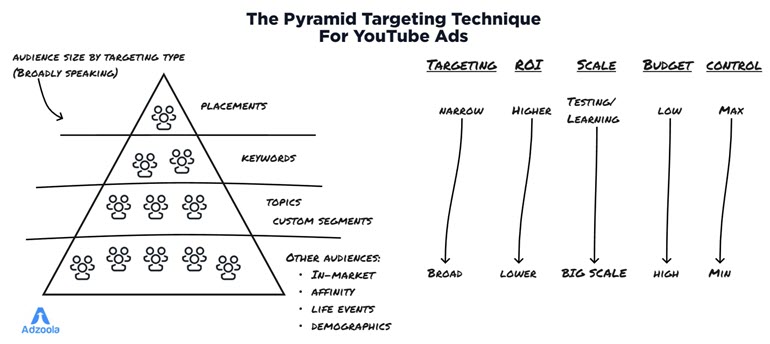
By following the Pyramid Targeting Technique and launching with focused placements, you minimize your upfront risk with lower budgets and maximum control. Once you’ve worked out your winning formula through this testing bed, you can scale your budget and expand targeting incrementally down the pyramid.
And, you can use it at almost any budget level.
If you’re a larger brand with a bigger budget and higher risk tolerance, you can skip levels of the pyramid entirely. Depending on your ability and willingness to go negative on profitability for a period, bigger players can take a more aggressive approach right away.
But for agencies, consultants and small-to-medium businesses, mastering YouTube placement targeting could be the safest and smartest first step for you.
Each successive level down the pyramid represents increased potential scale, but also becomes more hands-off and reliant on Google’s algorithms to optimize targeting. That’s why it’s so crucial for you to get your offering and messaging finely tuned and validated at the more controllable levels like placements first.
The pyramid provides you with a strategic framework to decide the appropriate starting point and level of risk based on your specific circumstances, risk tolerance and ultimate goals. The choice is yours, but this profitable, proven path is clearly mapped for you to follow.
Alex King is the founder of Adzoola and a YouTube ads specialist with over 14 years of media buying experience.
PPC
Google Shopping: A Beginner’s Guide to Crafting a Compelling Campaign Google Shopping: A Beginner’s Guide to Crafting a Compelling Campaign

With all the tools available online, there’s no limit to how you can advertise your eCommerce brand to consumers. With over 12-24 million eCommerce websites across the globe, what matters is how well you leverage these tools to help your business stand out from competitors.
There’s no better way to boost your online presence than with Google, responsible for handling nearly 8.5 billion queries each day. Google’s intuitive marketing tools, such as Google Ads, are trusted by more than 7 million marketers worldwide. If you’re running an eCommerce website, however, you need to be using Google Shopping Ads.
What are Google Shopping Ads?
Launched in 2012, Google Shopping is designed to help online retailers showcase their products visually. If you’ve ever gone looking for a particular item on Google, chances are you’ve come across them at the top of the search results page, lined up horizontally. There’ll be an image, product description, price, and store name. These are Google Shopping Ads.
Google Shopping Ads vs. Google Search
Google Ads and Google Shopping Ads serve different purposes. Google Shopping Ads are essentially product listing ads that help consumers easily learn about a product and where exactly to purchase them. Google Ads (or Google Search Ads) are text-based, relying heavily on copy, while Shopping Ads include images. Google Ads have a much broader scope since you can advertise anything using them, whether they be products or services. Google Shopping Ads can only be used to promote specific products.
The Benefits of Google Shopping Ads
Since Google Shopping Ads are typically displayed at the very top of search results pages, they will be the first thing consumers see when they search for products. This means increased brand visibility for online stores. By the same token, this type of ad can also help retailers reach out to a more specific demographic.
Since Google Shopping Ads collect product information, they can directly target the right audience for your line of business. Studies have also found that Google Shopping Ads achieve 30% higher conversions compared to traditional text-based ads, therefore ensuring better ROI.
4 Ways to Make Google Shopping Ads Work for your Online Business
Having explored the history and advantages of Google Shopping Ads, let’s dive into how you can include them in your eCommerce marketing plan to help you achieve online success:
1. Prioritize Product Feed
When creating Google Shopping Ads for your online store, it is imperative to include key information about your products. Google Shopping Ads highlight product names, images, descriptions, and categories – all of which are vital to your customers being able to find your products easily. For your product titles and descriptions, you may incorporate keywords that can make it a whole lot easier to search for specific items. Using appealing and high-resolution product images can give your website a boost in terms of click-through rates. Don’t forget to include prices.
2. Leverage Customer Reviews
When you look through Google Shopping Ads, you may notice some of them have star ratings. This is because Google allows retailers to display customer reviews in their ads to help promote their products. Studies have found time and time again that 93% of consumers check product reviews before proceeding with their purchases. Posting customer reviews can aid customers in making informed decisions and show them that your brand is trustworthy.
3. Optimize Campaign Structure and Product Groups
To see improve your ROI, you can try optimizing your campaign structure. This helps you manage your campaigns easily since it involves organizing certain aspects of your business such as product types and target customers. Organizing your products by categories can also help the Google algorithm accurately find the right items shoppers are looking for.
All you have to do is simply create different ad groups for different products. For example, if you’re running a clothing store, you can make a specific ad group solely for a specific kind of pants and aim them toward shoppers who are in need of this particular product. This will help your ads drive higher conversion rates and sales since they will only be seen by those who are interested in them.
4. Add Negative Keywords
As with search, one of the many features included in Google Shopping Ads involves the use of negative keywords. Negative keywords are phrases that prevent search algorithms from displaying results that are unrelated or irrelevant to what people are actually looking for. This feature increases search accuracy and makes it way easier for shoppers to find your products.
5. Categorize Ads By Demographics
Whether you wish to expand your reach or target a specific audience, it would be wise to organize your ads according to demographics. Collect pertinent customer data such as location, gender, age, shopping habits, interests, and frequent searches – this information can help you best determine what type of ads your audience will be inclined to engage with. Once you have these details, you can effortlessly target your ideal audience and promote your products among them.
6. Adjust your Bidding Strategy
Since you’re investing resources into creating your ads, it’s important to determine how much you’re actually willing to pay for them. If you’re able to maximize your Google Ads bidding strategies, you can help your brand rank better in search results. Here are some of the popular bidding strategies you can give a try:
- Target Cost Per Action (CPA) – for improving conversions by targeting a specific CPA
- Target Return On Ad Spend (ROAS) – for improving conversions by targeting a specific ROAS
- Maximize Conversion Value – for optimizing conversion value without targeting ROAS
- Maximize Conversions -or optimizing conversion value without targeting CPA
- Maximize Enhanced Cost Per Click (ECPC) – for automatically adjusting manual bids
-

 PPC5 days ago
PPC5 days agoHow the TikTok Algorithm Works in 2024 (+9 Ways to Go Viral)
-

 MARKETING7 days ago
MARKETING7 days agoA Recap of Everything Marketers & Advertisers Need to Know
-

 SEO6 days ago
SEO6 days agoBlog Post Checklist: Check All Prior to Hitting “Publish”
-

 SEO4 days ago
SEO4 days agoHow to Use Keywords for SEO: The Complete Beginner’s Guide
-

 MARKETING5 days ago
MARKETING5 days agoHow To Protect Your People and Brand
-

 SEARCHENGINES6 days ago
SEARCHENGINES6 days agoGoogle Started Enforcing The Site Reputation Abuse Policy
-

 PPC6 days ago
PPC6 days agoHow to Craft Compelling Google Ads for eCommerce
-

 MARKETING6 days ago
MARKETING6 days agoElevating Women in SEO for a More Inclusive Industry




